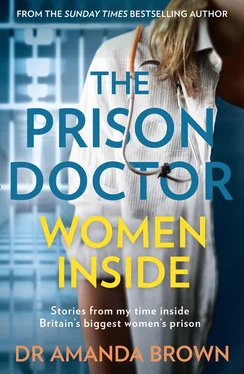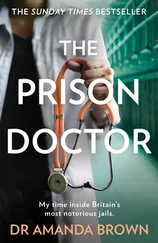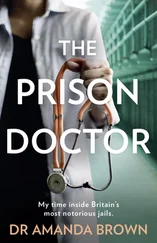‘To be honest, in some ways I’m happy to be back and have a warm place to sleep. It’s getting proper cold out there now. My sleeping bag got soaked in the rain the other night and it just won’t dry. And I’m starving,’ she rattled on. ‘I can’t just sit there all day. Shoplifting gives me something to do. That, and riding round the Circle Line. It’s warm, and much more comfortable than just sitting on the street. I also feel safer when I’m not sitting on the street. I’m so scared the dealers will find me and beat me up again.
‘It’ll be nice to be with some of my mates again. We understand each other. I’ll keep busy in here, maybe try and learn something; get back on the education programme. It’s good to know I’ll feel safe at night again, for a while.’
This was something I heard again and again from the prisoners. Being in prison for many women is far safer than being on the outside. She was back in a place she associated with safety, familiarity, security, and even opportunity. With three meals a day and regimented timetabling, she also wouldn’t need to make many decisions for herself.
As well as addictions to crack cocaine – a crystallised form of cocaine – and heroin, Shannon drank heavily and was addicted to benzodiazepines and pregabalin. Highly addictive, benzodiazepines – referred to as ‘benzos’ by the inmates – are drugs like diazepam and Xanax and were originally prescribed for anxiety when they first came on the market in the 1960s. Many girls I see are addicted to high doses of these drugs because it calms them down. Pregabalin is another prescription-only drug used to treat epilepsy, general anxiety disorder and neuropathic pain. Like heroin, it induces feelings of euphoria and calmness and is hugely addictive, so there is a rampant black market for this drug. Many of the women I see say that it is harder to withdraw from pregabalin than heroin.
‘It’s just so awful,’ they tell me, with haunted expressions.
Shannon was addicted to so much that withdrawal from it all was medically a blurred picture. Her face was glistening with sweat and her hands were shaking. As she looked at me, I could see that her pupils were widely dilated. She would experience a whole range of debilitating symptoms over the coming days and possibly weeks, including diarrhoea, abdominal cramps, nausea and vomiting, shivering, sweating, anxiety, panic attacks and paranoia.
I started typing out a whole list of medications that she would need to enable her to cope.
Methadone is prescribed as a substitute for heroin and helps to ease withdrawal symptoms from opiates and reduce the cravings. Bright green in colour, it is a slow-acting opiate substitute and is prescribed in a liquid form. Most people that take it say that it tastes disgusting. In the past, all prisoners were expected to detox completely from methadone if they were due to remain in custody for more than three months, but this is no longer the case. Often, especially in the case of a short sentence, it has to be ‘titrated up’, to try to protect the user from overdosing on release, or to control their dreadful symptoms of withdrawal.
Prisoners are given their daily dose by the nurses at 9 a.m. but if the dose is not high enough, it won’t hold them through until the next day.
We agreed on a dose to build up to, and along with methadone, I prescribed all the other medications she would need to combat her withdrawal symptoms.
‘I know I say this every time I see you,’ Shannon grinned. ‘But you really are like a mother to me. Thank you.’
I stood up to give her another hug.
‘Good luck, Shannon,’ I told her. ‘Be good.’
‘I’ll try, I really will.’
Deep down, I knew I would almost certainly be seeing her again after her current stay. I always, always hoped girls like Shannon would get their lives back on track, but it felt like she had the odds stacked against her. The statistics state that the more previous custodial sentences a woman has had, the higher her reoffending rate; the reoffending rate for women with eleven or more previous convictions is eighty-three per cent. It’s sad but it makes sense that just as women’s paths into crime are chaotic and complex, so their paths out to a better life are likely to hit just as many bumps along the road.

I glanced at my watch. It was just past 8 p.m. and I was feeling really tired and ready to go home. Despite the fact that I had been working in prisons for many years, I had never become immune to the rawness of it; the shock, fear, relief, sadness, shame, despair. It was a melting pot of extremes, and emotionally draining. So often, I was all too aware that I had very little to offer the people I was meeting, as I could not change the fact of where they were and what they had done. All I could hope to do was to try and offer a bit of kindness and reassurance, and to relieve any physical pain and suffering they may be going through. I try my best, if I possibly can, to take the edge off their undoubted apprehension, as I realise it must be so overwhelming and intimidating for some people to find themselves in prison. It is strange that whatever their crime and however awful, it fades into the background momentarily and I just see them as a scared and shocked human being. I am so used to the environment that I feel totally comfortable within the prison walls. But I find myself trying to imagine seeing it through their eyes, and wonder how it would feel if I was sitting in that chair opposite me.
As I was finishing off my notes on Shannon, Amber popped in to ask if I would like a cup of coffee.
‘I would love one. Thank you, Amber,’ I replied without giving it a second thought. ‘How has your day been? Any gossip?’ I asked her, hoping for a little light relief. Amber always cheered me up, as she is blessed with such a wonderful sunny nature and positive outlook on life.
‘Nothing much, Doctor Brown,’ she replied. ‘Same old, same old. I’m really happy though, because my family are coming to visit tomorrow, and I can’t wait to see them. Also, I’m reading a brilliant book – a thriller – which is really gripping.’
We chatted for a few minutes about the book and then she went off to get me a drink. It felt good to have people like Amber around. During my time working in Reception, I had become very close with the women who worked there and we tried to look out for each other. I thought how lucky I was to have them with me; we were like a little family and there was a lovely sense of belonging between us. Whenever I felt a bit down, they always managed to cheer me up.
A prison officer wheeled the next patient along the corridor, manoeuvring the heavy chair with some difficulty, taking a number of turns to get into my room.
In front of me was a black woman, in clean clothes and bright mauve lipstick. She was very overweight, with rolls of flesh sagging over the side of her chair.
I glanced at her notes. Gloria was 68 and had a multitude of medical complaints, including a condition that affected her joints. I read that she had already undergone two hip replacements. She also suffered from type 2 diabetes and hypertension, and was unable to walk due to the severe pain in her knees. This explained the wheelchair.
‘Hi Gloria, I’m Doctor Brown…’ I started telling her about what I was doing and why she had been sent to see me.
I went through my usual questions, one of which was to ask what she had been charged with.
Gloria explained that she had been charged with fraud, but she denied any involvement.
‘… but I didn’t do it,’ she said. ‘I got caught up in something I didn’t understand. I didn’t realise it was illegal. I’ve been given three years, Doctor Brown. Three years! Surely that’s not right?’ She looked at me imploringly. ‘I’ve never been in trouble before in my life.’
Читать дальше













